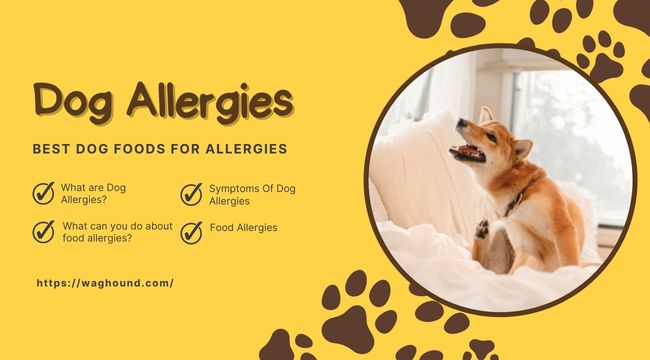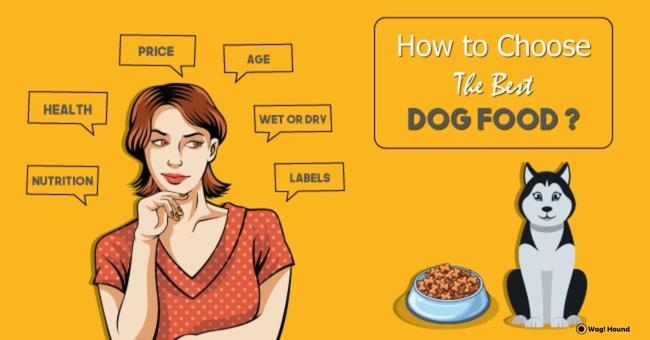
Waghound.com is an Amazon Associate, and we earn from qualifying purchases.
As a dog owner, one question that’s often weighed heavily on my mind is whether or not I was giving enough food and proper food to my dog.
I know I’m not alone; this is a question most dog owners ask themselves: “Am I doing everything right when it comes to my dog’s diet?”
While there are many dog foods available on the market to choose from, how can you know, which one is the best food for your dog?
At WagHound, we’ve done a thorough research and compiled a guideline for you to follow. This comprehensive guide will help you choose the best dog food for your canine friend.
After all, you do want to give them the very best, don’t you?
What is the Best Food for Your Dog?
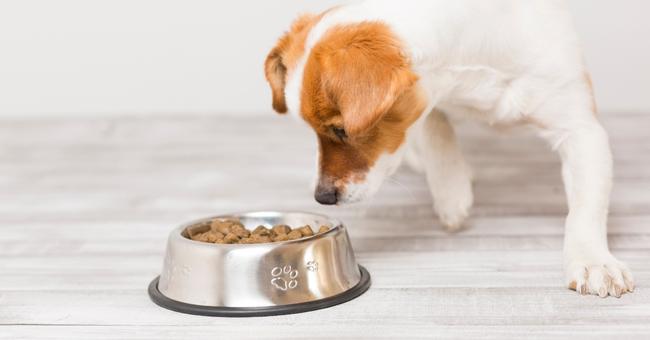
Before we get to talking about how to choose the best dog food, let’s consider what makes the right food for your canine friend.
Commercially Processed Foods are not Bad
While most of us feed our dogs commercially-processed dry or wet dog food, we aren’t really happy with the idea, are we?
However, the truth is, these processed foods contain nutrients in the most appropriate amounts at an optimal state that is required by your dog to have a good quality of life. We’ll discuss your dog’s nutritional requirements in the following sections.
Dog Foods with Meat, Grains, Fruits & Vegetables
Dogs aren’t omnivores; they can get their nutrition from not only meat but, also grains, fruits, and veggies, which are excellent sources of fiber, vitamins and essential minerals for your dog’s good health.
They Comply AAFCO Regulations
Most quality commercial foods are high quality, having to comply with strict regulations set by The Association of American Feed Control Officials.
AAFCO states that companies must follow set guidelines when manufacturing dog food. If a company is making claims on its label, be assured that it’s being regulated.
That being said, here are some of the things you might want to keep in mind that fall under AAFCO dog food regulations.
- A single ingredient food must contain about 95% of that ingredient, excluding water. For example, if a food company says the single ingredient is chicken, then, the chicken should make 95% of the food.
- If the word “flavor” is used in the ingredient list of the product then, it contains only trace amounts of that ingredients.
- If a food advertises words like dinner or platter then, there is about 25% of the named ingredient, and if the word with is used when there is only 3% of this ingredient. For example, if a product name reads “with salmon“, it means, there should be 3% salmon in the product.
They Follow AAFCO Nutritional Guidelines
Let’s have a look what AAFCO nutritional guidelines say:
Nutritional requirements:
A balanced meal will have about 30%-70% carbohydrates, 18%-25% protein, and 10%-15% fats.
Vitamins:
A healthy amount of vitamins such as vitamin E and vitamin A and minerals like phosphorus, magnesium, sodium, chloride, potassium, iron, zinc, and iodine is also important.
Water:
The right dog foods must contain enough water(even in dry foods) so your dog does not face dehydration. (But your dog needs to always have enough water to drink, in addition to the food, of course.)
Understanding Your Dog’s Dietary Needs

Your dog is your baby—we can relate! So, as a pet-parent, it is of utmost importance you understand the science of your dog’s dietary needs. How are you going to understand that?
Well, let us help you understand and determine your dog’s dietary needs in the following section.
Your dog’s dietary needs depend on your dog’s age, breed, activity level, environmental conditions, health and number of other factors.
Let us explain each of the factors below in detail.
#1. Age & Breed:
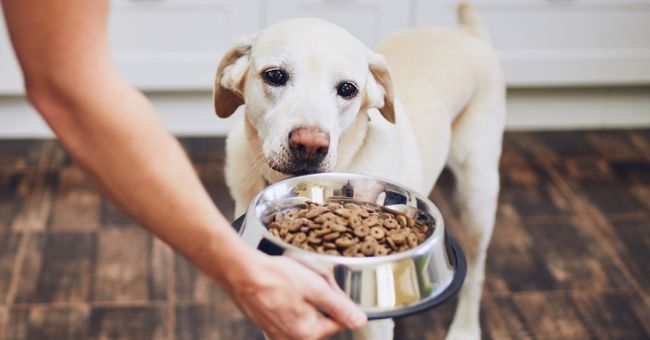
Age is an important factor in determining your dog’s needs—caloric and nutritional needs vary from age to age, as well as from one breed to another.
So, what does that mean exactly? Well, let’s take a closer look.
Puppies have the highest amount of nutritional needs and higher caloric needs compared to those of senior dogs.
But, the age at which a dog becomes senior varies, depending on his breed. For example, a Shih-Tzu may become senior at the age of 10- 12 years whereas, a Great Dane would become a senior at the age of 6.5 to 7 years.
#2. Growth:

As previously stated, the stage of growth is also important in determining the nutritional requirements of a dog. For example, a puppy who is growing needs about 22% protein and an adult dog of the same breed would require about 18% protein.
#3. Environmental Conditions:

Some dogs spend their time outdoors, in extremely low temperature, and as such, they need at least 10% to 90% more energy than dogs who enjoy moderate temperatures.
To elaborate a bit more, in response to cold, it’s a given—your dog will shiver, which leads to higher oxygen consumption. Typically, if your dog spends more time outdoors, for every 20° F drop, they will need 15% more energy to regulate and maintain their body temperature.
Then again, other factors like the coat thickness, body fat and shelter also affect your dog’s caloric needs.
#4. Health Conditions:

If your dog is ill, they will need more food and calories to heal. Why? Well, a response from the immune system takes up more energy.
#5. Reproduction Stages:
Like all animals, a pregnant female dog has increased energy needs in order to sustain herself and the fetus.
During the first weeks, an approximate 10% increase in the regular food intake should be enough.
However, this amount should be increased to 15%-25% at the time of whelping.
It’s important to choose foods which are easily digestible, as well as palatable. Make sure that her food contains at least 29% protein and 17% fat.
#6. Lactation:
Again, a lactating mother needs more calories than a non-lactating female dog. For example, it’s advised to increase her food consumption by 25% (per puppy) versus what is normally fed.
#7. Neutered Dogs:
It’s suggested that due to lower activity levels, neutered dogs have a reduced need for energy and hence, calories.
#8. Activity Levels:

It’s obvious that more active dogs need more energy and hence, more calories than their less active counterparts to maintain their weight and overall health.
After taking all these factors into consideration, consult your vet about your pet’s diet. Especially if your dog is suffering from any diseases like allergies, diarrhea, kidney problems, etc. that may be alleviated by diet.
Nutritional Needs for Dog Breed Sizes
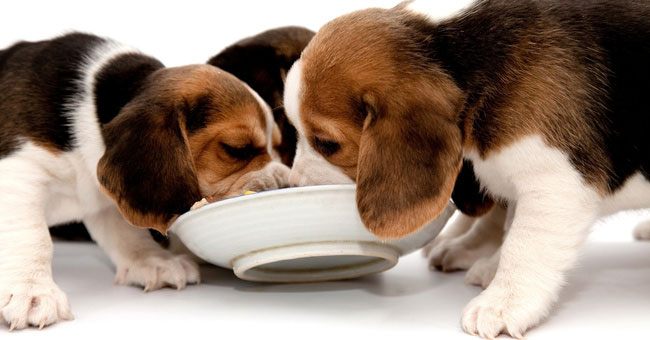
As we have already discussed above, the nutritional needs vary depending on the age and size of your dog, let’s now have a look at how much nutrition does your puppy need or how much nutrition does it requires for different sizes of breeds.
Keep in mind that the nutritional requirement is very different for dogs with special dietary needs.
1. Nutritional Requirements for Puppies:
Puppies are very special and have specific nutritional requirements; the nutrition you give your puppy at this life stage will influence the quality of life they lead at a later stage.
Ensuring proper growth and development isn’t an easy task. Young animals are prone to dietary deficiencies along with being sensitive to toxins. Low-quality ingredients can have an adverse effect on their health.
How Much Should I Feed My Puppy?
Puppies should be given a more calorie-dense food than adult dogs—about 445 Kcal per cup, to be specific.
Also, the nutritional requirements will vary because they need about 22% protein and 8% fat in their diet. The rest of their nutrition would have to be from other vitamins and minerals.
Also, remember that puppies should be given quality food that meets the AAFCO requirements.
It’s important to incorporate omega acids, a high amount of amino acids and minerals (as stated above).
In addition, factors around health and your dog’s breed must be kept in mind when it comes to choosing food for your dog.
Why? Well, for example, large breed dogs are more at the risk of having orthopedic diseases; hence, if you own a large breed puppy, you should make sure that the calcium to phosphorus ratio is in balance.
2. Nutritional Requirements for Small, Toy and Large Breed Dogs:

Most dogs seem to have similar requirements when it comes to nutrition, but that is not the case.
There are certain differences that must be considered while we are talking about nutritional requirements, especially breed to breed.
How Much Should I Feed My Toy, Small, or Large Breed Dog?
Small breed dogs have very high rates of metabolism, so they need to take in a sufficient number of calories (more calories per pound than large breed dogs) to regularly meet their needs.
A general rule is a small breed dog requires about 40 calories per pound of body weight and a large breed dog might need about 22.5 calories per pound of body weight.
That being said, the nutrient requirements remain more or less the same. For example, adult dogs need about 18% protein and 5% fat in their diet with the other vitamins and minerals.
3. Nutritional Requirements for Dogs with Special Needs:

You will also find dogs that have food requirements based on their special needs. For example, dogs with allergies need a special diet and dogs with sensitive stomachs needs careful consideration.
While looking for food for them, look for a “complete and balanced diet”.
In addition, make sure their food has a number of hypoallergenic ingredients; this will support their sensitive stomachs or be easier on their allergies to avoid flatulence and other adverse reactions, again depending on the condition of your dog.
Transitioning Food for Dogs with Special Dietary Needs:
When a sensitive stomach or other health issue has been detected in your dog, there has to be a transition that will be easy on your dog—that is to say when you’re changing from one brand/type of food to another.
So, make the transition slowly so that it is easier on them. One way would be by mixing about 10% of the new food with about 90% of their old food; then you can gradually change the proportions bit by bit until they’ve transitioned to the new food completely.
Misinformation About Dog Food:

We have discussed the nutritional requirement of dogs and some of the important things you should look out for. Now, let’s take a look a few of the myths and misinformation.
#1. Pork is Harmful to Dogs:
You will find several sites on the Internet which warn about how pork can be harmful to your dog because of its high-fat content, suggesting it will lead to obesity or pancreatitis.
In addition, it is also implied (or sometimes stated outright) that pork meat contains compounds that are toxic to dogs.
This, however, is not the case.
Pork is a source of high-quality protein and amino acids which can be easily digested. In addition, it’s also less likely to cause an allergic reaction in comparison to other protein sources.
#2. Lamb is Hypoallergenic:
A meat that is hypoallergenic for one dog may lead to allergic reactions in other dogs, depending on the dog’s condition.
It’s not possible to make one, sweeping statement. That being said, it’s simply not true to say that lamb is hypoallergenic.
At one point, it was considered hypoallergenic, but that was probably due to the fact that it isn’t consumed as much as other meat; as a result, it was unlikely that dogs would develop an allergic reaction to it for the simple reason that it was uncommon.
#3. Kidney Failure is Attributed to Protein:
Urea is a byproduct of protein metabolism; dogs having kidney problems allow urea to build up in the bloodstream, which makes the dog sick. Hence, protein can be given to dogs at optimum levels.
If a dog doesn’t consume enough proteins, really low amounts of proteins will lead the body to draw protein from its own muscles and strain their bodies.
#4. Meat is More Nutritious Than Meat Meal:
Well, no. If the ingredients state that there is chicken, it means that there are chicken and water—the weight is higher. But, chicken meal is comprised of chicken with water and fat. Although it weighs less than chicken, the amount of protein is definitely higher.
#5. Grain is Bad for Dogs:
Some dogs are allergic to grains, so somewhere along the way, a myth started suggesting that grains are harmful to dogs. But the truth is, grains are okay for most dogs.
#6. Raw Eggs Help to Promote a Shiny Coat:
There is absolutely no evidence to prove that raw eggs help promote shiny coats.
Eggs are a great source of proteins, fats, and minerals, but as far as actually promoting a shiny coat? There is absolutely no such evidence. In fact, raw eggs contain bacteria that might cause havoc in your dog’s system, so don’t go believing everything you read.
#7. Dogs Do Not Like Variety:
Most dogs prefer to have variety in their diet. In fact, if there isn’t variety in your dog’s diet, there’s a high chance that over time, they will develop allergic reactions because of consuming the same kind of diet over prolonged periods of time.
Expensive vs. Cheap Dog Foods

Dog diets are dependent mostly on the breed, activity level and health requirements of the dogs.
Whether to give your dog an expensive brand or a cheap brand, in reality… it doesn’t really matter, as long as the diet being given is “complete and balanced” with all the nutritional requirements for your dog.
Note: canned dog food is more expensive than dry dog food.
Read on to decide whether you want to give your dog wet dog food or if dry dog food may be a better option.
Dry vs. Wet Dog Food:
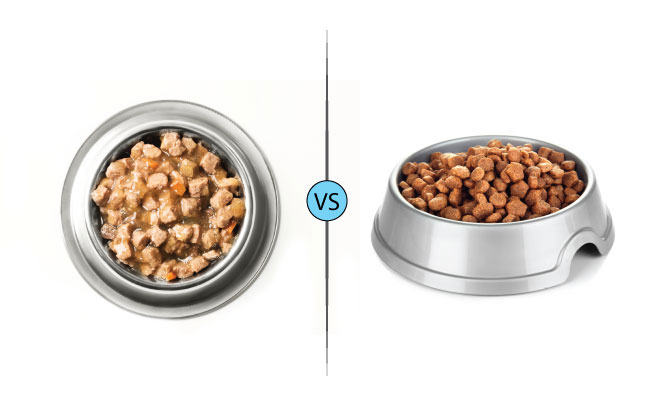
When it comes to choosing a dog food off the shelf for your dog, you have a choice of opting for either dry dog food or wet dog food.
Which one would be best depends on your dog and their dietary needs.
After thorough research, we’ve listed some of the things that will help you decide between dry dog food with wet dog food.
What is “Best Dry Dog Food”?
Dry dog food contains about 90% dry matter and 10% water and is made by cooking meat and grains which are then preserved into an easily digestible form. Once opened, they don’t require refrigeration and are easy to store.
If you end up opting for dry dog food for your dog, you might be thinking, “What exactly should I be looking for?” Well, read on to find out the must-have components to look for in the best dry dog food.
Must-Have Ingredients in a High-Quality Dry Dog Food:
Here are some of the most important things to look for when you go to buy dry dog food for your pet—make sure that it contains some of these ingredients which are indicators of high-quality dog food.
#1. The first two ingredients should be whole meat sources:
Meat is an excellent source of protein and it’s necessary to keep up with your dog’s nutritional needs.
That means it’s always a good idea to give your dog a food that has meat listed in its first three ingredients.
#2. Go Unprocessed:
Nutrients thrive best when the food is whole and unprocessed.
So, look out for dog food labels that have the words “whole” and “unprocessed grains and vegetables” written on them; this way, you can rest assured that the goodness of vitamins and antioxidants is still intact.
#3. “Specific” Higher Quality Protein Sources:
Once again, we will emphasize proteins because their value cannot be emphasized enough! But, this time look at the source of protein.
Makes sure it’s stated as a whole, fresh or single. For example, go for a product that states “chicken meal” instead of “poultry meal” or “meat meal”.
Which Dry Dog Foods to Avoid?
When you skim through dog food labels, if you come across these ingredients, avoid them if you can.
#1. Meat By-products:
By-products are second-rate ingredients that are not exclusively meat. Instead, it’s actually the non-rendered parts of animals that we get from slaughtered mammals like kidneys, brains, blood, fatty tissues, etc.
It’s one of the cheapest ways for companies to reduce their cost of production. So, you better avoid dry dog food made of by-products next time.
#2. Generic Fat Source:
When they say animal fat in a label, don’t buy it. It could be anything from a mixture of fats to recycled grease. Instead, look for options that say “beef fat” or “chicken fat”—they’re much better options.
#3. Artificial Preservatives:
Though artificial preservatives preserve the food more than natural preservatives, it’s always better to avoid foods which contain artificial preservatives as they might be harmful to your dog. Some artificial preservatives include BHA, BHT, ethoxyquin, etc.
#4. Artificial Colors:
Artificial colors are unnecessary and harmful to dogs, so it’s best to avoid them at all costs. And honestly, we doubt if your pet has any color issues with his food.
#5. Artificial Flavors:
This is another unnecessary ingredient—your dog could easily do without because, usually, meat flavors are appealing enough on their own for any dog.
#6. Artificial Sweeteners:
While dogs like sweets, dietary sugars used in dog food may have a negative impact on your dog’s health; they could actually worsen your dog’s existing health problems, such as diabetes.
What is “Best Wet Dog Food”?
If your dog is not comfortable with dry dog food, a more palatable option is wet dog food or canned food which is, as mentioned above, more expensive than dry dog food.
Wet food, as the name suggests, has higher water content with a greater amount of fresh meat and protein than grain.
Just like dry food, it’s important to understand your different wet food options. It will vary, depending on their nutritional needs; it’s always a good idea to consult your vet.
So, what should you be looking for when it comes to buying wet food for your dog? Read on to find out.
Must-Have Ingredients in the Best Wet Dog Foods:
As with dry foods, even canned dog food must contain some essentials in their key ingredients.
So, when you are looking for wet dog food, look for the following:
#1. Proteins Sources:
Look for protein from a specific animal in the key ingredients list.
#2. Grains, Whole and Unprocessed:
Go for products that say “whole and unprocessed” in their labels and having ingredients such as brown and wild rice.
Also, try to avoid wheat and gluten as much as possible—they are potentially harmful to your dog’s health.
#3. Vegetables:
It is always better to buy dog food containing whole non-starch vegetables like carrots or apples.
You’ll find potatoes and sweet potatoes in most wet foods as they are thickening agents. In fact, most companies use them to thicken the food; keeping that in mind, make sure that there are other vegetables and fruits as well.
Also, make sure that potatoes are not listed in the top four items in the ingredient list; if they are, it could mean that the food lacks other key sources of nutrition.
#4. A complete and Balanced Diet:
Finally, make sure that the wet food you are buying has passed the AAFC trial and has a nutritional label attached to the packaging. And this point stands true not only for wet dog food but for dry dog food too.
Which Wet Dog Foods to Avoid?
Similarly to dry dog food, you’ll want to avoid canned dog foods if it contains by-products, non-specific animal sources, artificial sweeteners and artificial preservatives. In addition, watch out for food binders—ingredients that hold the meat together to make it seem like the meat is in bigger chunks.
The most common food binders are gluten and various gums.
Understanding the Dog Food Labels:
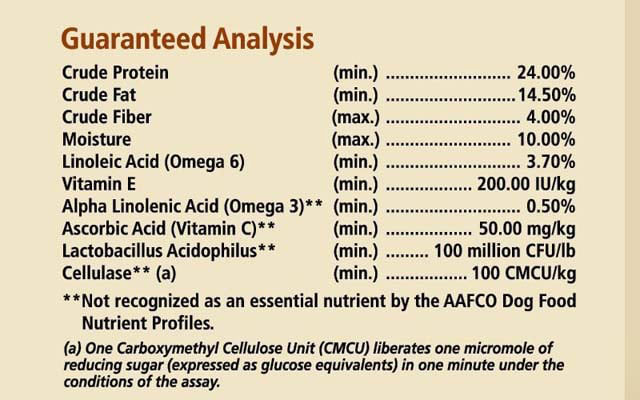
Dog food labels contain the product name, ingredient list, net weight of the product, name and address of the manufacturer, guaranteed analysis, list of ingredients, the intended animal species (word “dog” in this case, as we are talking about dog food here), the statement of nutritional adequacy, and feeding guidelines.
Some product labels also contain the calorie content information of the food Also, watch out for feeding trial information to check if this food has previously been fed to living dogs.
While reading the food labels, you might have a couple of questions come to mind.
Here are some answers to frequently asked questions that will hopefully help fill in the blanks.
#1. What is a Guaranteed Analysis in Dog Food Labels?
The guaranteed analysis is the minimum amount of crude proteins, fats and water content in the food. It also lists the maximum amount of fiber and moisture.
It’s not the actual amount of the product, but it’s the minimum amount that’s required to be present in the food.
When you’re comparing different foods on the basis of the guaranteed analysis, you might want to consider the dry matter or caloric basis of comparison.
To be clear here, while comparing, it’s better to make a comparison between two dry dog food brands rather than between dry dog food and wet dog food so that you’re comparing “apples to apples”; otherwise, the comparison won’t be fair. For example, most dry dog food will have approximately 10% water, whereas wet dog food can contain about 75% of water.
#2. What Does the Ingredient List in Dog Food Labels Really Tell Me?
Dog food ingredients are generally listed in accordance with their weight in decreasing order but don’t forget to take moisture content into consideration.
For example, if beef is the key ingredient and it contains about 75% moisture then, then the contribution to dry food may actually be much lower.
When you look at the preservatives or any other artificial colors or stabilizers in the food, make sure that they are FDA approved.
Unfortunately, the grade of ingredients is usually not mentioned, so in this regard, it becomes difficult to accurately evaluate the product.
#3. What Does the Statement of Nutritional Adequacy in Dog Food Labels Mean?
Nutritional adequacy is a statement that is in line with AAFCO regulations as it is an indicator of how the food was tested and for which life stage the food is intended for.
It is interesting to only four life stages growth, maintenance, gestation, and lactation are recognized by AAFCO.
If a product says it’s complete and balanced, it’s an indicator that the product contains most of the nutrients required and is well-balanced to meet the energy density required.
These claims are usually made after the product has gone through AAFCO feeding trials to confirm it contains the minimum requirements, as per AAFCO guidelines.
But, bear in mind, some snacks and/or dietary products can be excused from AAFCO testing.
#4. What Does the Feeding Guidelines in Dog Food Labels Mean?
Feeding guidelines are clear indicators on how to give the product to your dog.
You’ll notice that they’re generally expressed as feed (weight per unit of product) per body weight of the dog.
These guidelines are listed in order to monitor the amount of food given and to avoid overfeeding or underfeeding.
With those questions answered, make sure you do not fall into traps that manufacturers use to attract customers. An example is the words “ultra-premium”—that’s just advertisement hype and it’s misleading.
There are certain terms however like “natural” that are recognized by AAFCO. What that means is that if a product states natural it means the food contains ingredients from plants, animals, and other mined sources.
If a product states “organic”, it means it’s made without the use of pesticides or artificial fertilizers—in other words, processed without food additives.
How Does the Right Dog Food Help Fight Health Problems?

When it comes to selecting dog food and thinking about your dog’s nutrition, any health issues your dog might be facing has to be taken into careful consideration; it’s important to consult the vet before choosing a dog food.
Make sure to take your vet for a wellness examination, either to help them with any current problem or just to check if they are prone to any kind of disease that may be genetic or otherwise.
Prescription Diet
If your dog has been prescribed a commercial prescription diet, make sure to talk about it in detail with your vet; find out the specific nutritional needs of your dog so that you are able to give better quality care and food without any gaps in their specific nutritional requirements.
Why? Wouldn’t a commercial prescription diet be balanced? Actually, no because prescription commercial diets often target a specific nutrient so, some of the other nutrients may go missing and this is bad for your dog’s health.
For example: if the goal of a prescribed diet is to give high-quality protein, and low amounts of phosphorus and calcium in order to fight bladder stones, then there may be an appropriate amount of protein but, lower fat in the diet.
Hence, in order to balance it, you can customize foods accordingly, using both raw and commercial options rather than giving your dog a single commercial option which may not fulfill their specifically prescribed nutritional needs.
Related: Dog Vaccination Guide: The Right Vaccination & Schedule
Health Issues that Can Benefit With Proper Diet Management are:
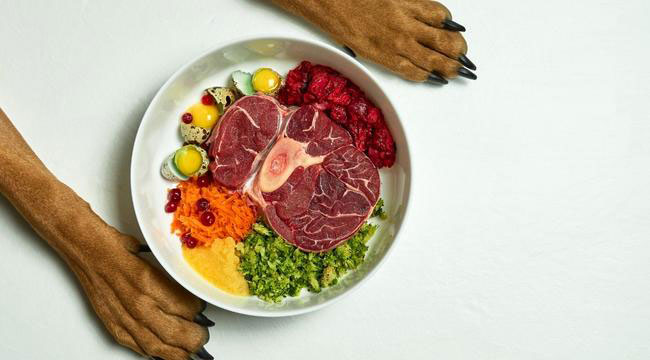
#1. Allergies:
Some breeds of dogs are especially prone to allergies; especially allergy-delicate dogs include Labrador Retrievers, Cocker Spaniels, Dalmatians, etc.
Food allergies are the most common type of allergy in dogs and can be treated with an elimination diet by simply eliminating the allergens from your dog’s diet.
It’s very important to carefully record the ingredients in your dog’s food in order to take precautions later on.
#2. Cancer:
Cancer patients should be given a high fat, low carb diet. Why? This helps starve cancer cells from growing and at the same time, allows your dog to get a good amount of energy from high-quality fat.
#3. Inherited Metabolism Disorder:
Some dogs are more susceptible to diseases based on their diet. For example, some breeds like Cocker Spaniels may suffer from a buildup of copper in the liver, whereas Siberian Huskies may genetically suffer from a zinc metabolism disorder.
#4. Arthritis:
A specialized diet may help a dog suffering from arthritis. It can help them maintain their weight because as an increase in weight can lead to worse arthritis (which is painful).
Related: Arthritis in Dogs- Natural & Other Treatments Guide
#5. Heart Diseases:
If your dog’s diet is not properly balanced, they may get heart disease just like humans.
One of the major ways to prevent heart disease is by controlling the amount of sodium in your dog’s diet. Increased sodium may lead to water retention in the blood vessels as the sodium is circulating in the blood—this puts a strain on your dog’s heart.
#6. Pancreatitis:
An increased amount of fat in their diet can cause inflammation of the pancreas.
If your dog is suffering from pancreatitis, it is recommended to give a more bland diet with lower amounts of fats and easily digestible food.
The importance of health must never be undervalued, hence, take all the factors like health history and your dog’s condition into consideration.
Decide on the basis of all of this information, in consultation with the vet, on the appropriate diet for your dog.
Making a Choice: What is the best food for your dog?
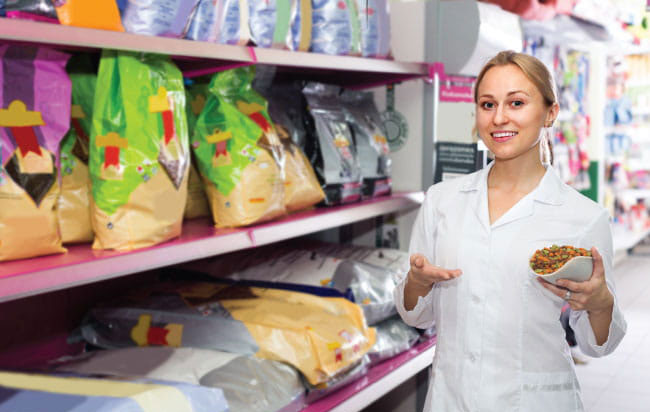
Building on the previous information provided, here’s an overview of the things you should keep in mind when buying food for your pet.
#1. Don’t Get Carried Away by Advertisements:
Once you know and understand what essential ingredients are in the best dog food, there’s a better chance you won’t get carried away by advertisements.
Do some research for the sake of your canine friend.
#2. Decide on the Wet or Dry Dog Food:
Whether you choose a wet dog food or a dry dog one depends on you and your dog.
It’s a matter of which one appeals more to your dog’s taste buds and a question of what you can afford.
#3. Look Out for AAFCO Statements:
As we stated earlier, guidelines provided by AAFCO state the requirements of a dog’s diet.
So really, having an AAFCO label is a kind of assurance that the minimum requirements are being met—you don’t have to worry
#4. Ensure the Required Ingredients are Present:
Make sure to go through the ingredients list, understanding the amount of each ingredient and their nutritional contribution to your dog’s diet.
#5. Compare Between Brands of Dog food:
Compare carefully between brands by going through their ingredient list and separately understanding which one provides more nutrients per ingredient; depending on the needs of your dog, then you can choose the best one.
#6. Get the Proximate Analysis Right:
This refers to the amount to be fed to your dog per pound of body weight.
The guaranteed analysis will give you the minimum requirements of crude proteins and fats.
#7. Ensure Good Packaging:
Packaging matters when it comes to ensuring the freshness of the food. Don’t get carried away by cute pictures on the package.
While buying food, make sure:
- The bag of food is still intact without any holes in the case of dry dog food. Sure, but why? Well, it’s because any exposure to heat or light will make the food go stale.
- Check the date of production and expiry date (or even sell by) to get fresher food.
#8. Finally, Store Your Dog Food Properly:
Make sure to store your dog food well. If food is not stored properly, it will become inedible and it’s quite a waste.
Dry food should be stored in an airtight container with minimum exposure to heat and light. It is recommended to use it within six weeks of opening.
Canned food should always be refrigerated once opened. If unopened, store the cans in a cool and dry place.
In Conclusion
Everyone will try to sell their you product, but when it comes to choosing the right dog food for your pet, remember you are the best decision maker.
We have only given you a guide and hopefully, it’s one that will help you make an informed decision when it comes to picking your dog’s diet.
Like responsible pet-parents, it ’s important to have a clear understanding of your dog’s needs and also to do sufficient research in order to give them the very best.
